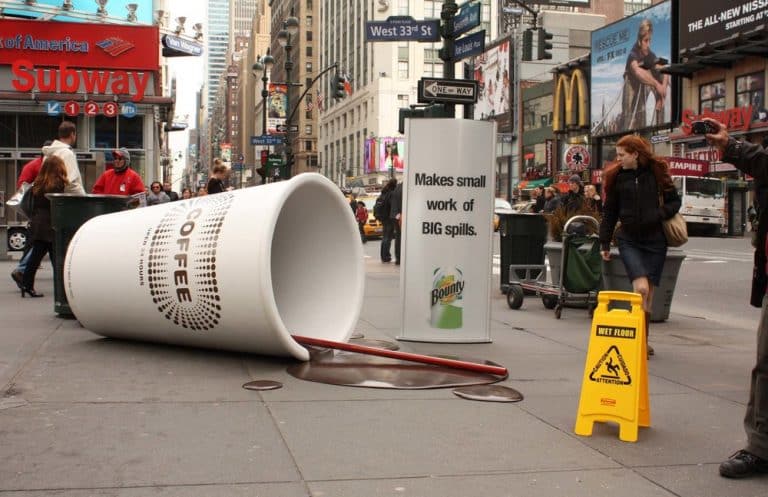How can a company without resources grow in today’s competitive market? Guerrilla marketing makes up for the lack of resources with a large dose of audacity and creativity. This is a concept that was conceptualized by Jay Conrad Levinson back in 1984 and has remained very popular to this day.
Guerrilla marketing is a strategy that can be followed by any company, regardless of its size or its industry ranking. According to experts familiar with the matter, in each sector, out of every one hundred companies, generally one must play on the defensive (the sector leader), two on the offensive (to take the lead from the first), three must flank and the rest must be guerrilla. The guerrilla has the potential for tactical advantages that allow dynamic and innovative SMEs to thrive in the land of giants.
There are a lot of ways to employ guerilla marketing. One strategy is to use personalized pens and pencils. You can give out pens and pencils with your company name on them, which will increase visibility. Everybody that sees the pen might become a future customer. This could be a great guerilla marketing idea, because it costs far less to make personalized pens or pencils than to run a marketing ad.
They are small companies that do not follow the mainstream. They survive by striking out and hiding, and by exerting a very powerful attraction on a small part of the population. They show an attacking mentality because they have nothing to defend.
Competitive environment
Small, guerrilla companies can not only survive, but they often conquer very juicy portions of the market and undergo significant growth. In fact, almost all the big companies were, in their early days, small businesses that used extraordinarily creative marketing strategies. One of the best examples is how Michael Dell beat IBM during his freshman year in college. How did they manage to accomplish this? Some of the strategies included:
- By coexisting with the big ones. The big companies leave many aisles open that are impossible for them to cover. Reaching certain niches would be for them at a cost they don’t even consider. These are the gaps that SMEs can fill without having to face the big players.
- Specialist markets. Experts recommend the path of specialization to grow and be profitable. There is no large area with as many possibilities as a company specializing in whatever gives it an edge. It does not have as much supply and, of course, it also has the additional advantage that they become, rather than sellers, consultants who advise the customer on what is best for him.
- Differentiate yourself from the competition. It is important to be perceived as unique and differentiated from the competition. If you can differentiate yourself based on products, services, sales aspects and pricing, you have many options. However, choose one main factor with which to distinguish yourself. This reduces confusion on the part of the customer, and you are reaffirmed.
Positioning
But what are the main strategic positionings that guerrilla companies can adopt? Some of them are listed below:
- Geographic guerrillas. Some guerrilla SMEs concentrate their resources in a limited territorial area. They narrow the battlefield to achieve superiority of forces. Targeting by geography is the traditional way to achieve this objective. In a given city or town, it is common to find a department store larger than the local Sears, a restaurant larger than a McDonald’s, a hotel larger than a Holiday Inn. In other words, one must strive to become a big fish in a small pond.
- Demographic Guerrillas. Seek to attract a specific segment of the population, establishing, for example, specific categories by age, income levels and occupation. Thus, there are companies specializing in products for the elderly, IT for lawyers. Some guerrillas combine both geographic and demographic targeting.
- Sectoral guerrillas. This consists of focusing on a very specific and specialized economic sector. For example, the software company that specializes in IT solutions for the banking market.
Guerrillas at the high end. For many products, a high price is a quality that gives it added credibility. Some products claim to be the world’s most expensive SaaS platform or perfume in their advertising campaigns. But this strategy requires the product to be endowed with additional qualities and devices that justify the price difference. Quality and high prices are the cause that creates the mystique that creates the demand.
What are their weapons?
Resource-poor, guerrilla companies are not helpless. Quite the contrary, they have many strengths to succeed:
Greater speed. A guerrilla leverages its small size to make quick decisions. The defense of small businesses is their lack of a bureaucracy, their speed, their ability to adapt quickly to changing situations and new customer needs.
Greater proximity to the market. Direct contact with the customer leads them to immediately notice changes in their tastes, so they can quickly introduce the relevant improvements, without having to wait for the conclusions of a market study.
Pioneering zeal. Their continuous search for opportunities often leads them to be the pioneers of new markets which, over time, acquire a large dimension.
The indifference of the big players. One of the advantages of guerrilla companies is that they almost always occupy such a small market that they do not arouse the appetite of large firms. This allows them to survive in markets that can be highly profitable.
Reflections. If, on the other hand, a large company assaults their market, they have the quick reflexes to withdraw in time and look for other markets with greater possibilities.
Not emulating the leader. They never attack the big companies, but manage to become their complement.
There are a lot of great benefits of being a guerilla marketer. This can help you stand out and thrive if you follow these tips.


